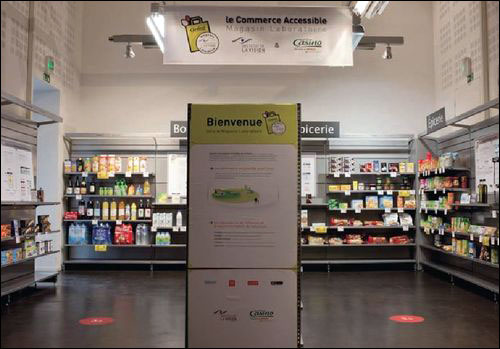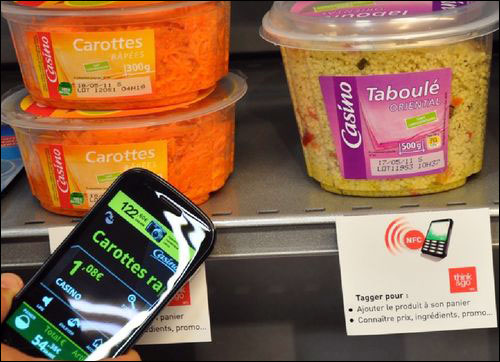Sep 21, 2011French supermarket chain Groupe Casino, with assistance from the Institut de la Vision, has opened a laboratory store in Paris in order to model a solution involving Near Field Communication (NFC) technology, and to learn how it could be employed at stores to improve the shopping experience for the visually impaired or elderly. By using an NFC-enabled phone, a shopper with some visual disability can tap an NFC tag on a shelf label and view much larger, clearer text than that printed on product packaging, as well as read details regarding that product, such as ingredients, nutrition details and recipes. The system, known as Accessible Shopping, is being provided by Think&Go NFC, a French provider of NFC solutions.
Assistance to the visually impaired, however, may be just the beginning for the technology and its applications for customers in Casino's stores, says Thibault de Pompery, the creative director of Groupe Casino's innovation department. Once such an NFC system is installed at the retailer's locations throughout France, anyone equipped with an NFC-enabled mobile phone could access product information, fill a shopping cart virtually, pay for products via PayPal or some other payment system, and then either have the goods delivered, or pick them up at the front of the store. What's more, he adds, a shopper could make purchases outside the store by, for example, tapping his or her phone on NFC tags embedded in a smart poster at metro stations or other locations.

Initially, the deployment consists of approximately 100 NFC 13.56 MHz passive tags manufactured with NXP Semiconductors Mifare Ultralight RFID chips, and attached to shelves in a mock Casino store, enabling researchers to test the use of NFC technology to improve the shopping experience for the visually impaired. The customers of concern are those who can see, but who may have trouble reading small text found on food packaging within a supermarket, or who may have central or peripheral vision impairments. Groupe Casino has been working with the Institut de la Vision to determine what impediments the visually impaired face at a supermarket, and how these issues can best be addressed. After discussing various solutions with Think&Go NFC, the researchers determined that NFC technology could make previously illegible data appear larger and more clearly displayed on a mobile phone screen.
To test the system prior to its installation at one of Casino's stores, the retailer, with help from Think&Go, has set up the Accessible Shopping Magasin Laboratoire (Laboratory Store). The lab is utilized by a panel of partially sighted individuals, as well as experts such as optometrists and ergonomics specialists.
According to Casino, the percentage of France's population over age 65 is now 25.5 percent, though that number is expected to increase to 35 percent by 2030. During the same span of time, the percentage of partially sighted people is predicted to rise from the current 3 percent up to 5.5 percent.
However, says Tim Baker, Think&Go's NFC marketing director, the technology can do far more than simply provide product information. The system could be designed, for example, so that every time an RFID label is tapped, the corresponding product is automatically placed in that user's virtual shopping basket. If the shopper then reads about a particular product and chooses not to purchase it, he or she can simply press a prompt on the phone's screen to have that item removed. The user could also scroll through other goods that may be similar to the item selected, and comparison-shop using the mobile phone. Once finished, the shopper can press a checkout prompt and pay for the items via PayPal or some other account. If a user desires specific products that might not be present—fresh strawberries, for instance—that person can indicate his or her wishes via the phone application, and receive notices when those items become available at the store. The customer could also create a menu, input the items desired to complete that menu, and view a list of products, as well as pricing or calorie information for some or all of the items.

Additionally, the system can issue alerts to a shopper via mobile phone if he or she selects an RFID tag for an item containing ingredients that the individual has indicated are an allergen or other health hazard.
De Pompery says he expects Casino to complete testing by the end of this year. At that time, he says, the company will determine how to proceed with deploying an NFC solution at any of its stores, based on the results of testing conducted at the store laboratory,. "What's interesting is that everything can be done on a single device," he explains. "We think we have several ways to help our customers," he adds, including assistance with visual disability, learning more about a particular product and making purchases.
The technology may provide other options as well, Baker says, such as enabling a company like Casino to set up a store containing very little product, with shelves stocked simply with empty packaging fitted with RFID labels. At such sites, shoppers could select the items they would like to purchase and then have them delivered, or can pick them up at a separate drive-through location. Such solutions might be popular for customers without cars, he notes, or those living in city centers, far from the supermarkets more typically located in suburbs.

